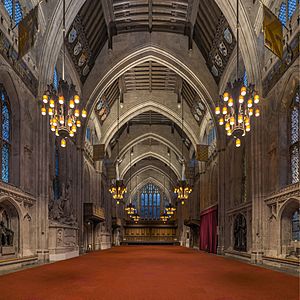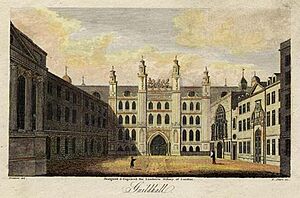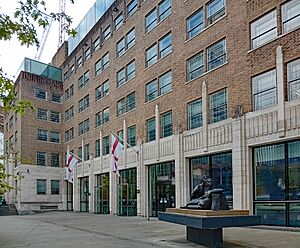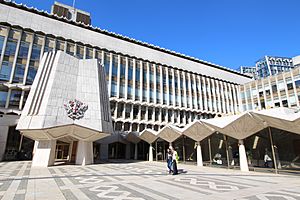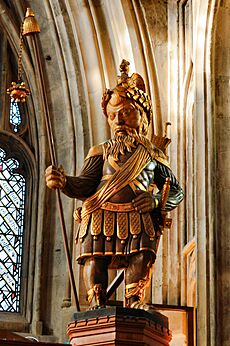Guildhall, London facts for kids
Quick facts for kids Guildhall |
|
|---|---|

The façade of Guildhall
|
|
| Type | Civic building |
| Location | Guildhall Yard, EC2V |
| OS grid reference | TQ 32485 81384 |
| Area | City of London |
| Built | 1440 |
| Owner | City of London Corporation |
|
Listed Building – Grade I
|
|
| Official name: Guildhall | |
| Designated | 4 January 1950 |
| Reference no. | 1064675 |
| Lua error in Module:Location_map at line 420: attempt to index field 'wikibase' (a nil value). | |
The Guildhall is a very old and important building in the City of London, England. It's like a town hall for the City of London. This building has been used for hundreds of years. Today, it's still the main place for important ceremonies and for running the City of London.
It's important not to mix up Guildhall with London's City Hall. City Hall is the main office for the wider area of Greater London. The word "Guildhall" can mean the whole building. It also refers to its biggest room, which is a huge medieval hall. This historic building is officially recognized as a Grade I-listed building. This means it's very special and protected.
Contents
History of Guildhall
Ancient Beginnings: Roman and Medieval Times
Did you know that Guildhall stands on a really old site? During the Roman period, a huge amphitheatre was here. It was the biggest one in Roman Britain! Parts of it were found in 1988. You can even see some remains in the basement of the Guildhall Art Gallery. The shape of the old arena is marked on the ground outside.
People think the Saxon Guildhall was built here because of the old Roman ruins. The first time a London Guildhall was mentioned in writing was around 1127. Digs have also found foundations from that time. There's even a legend that says this spot was once the palace of Brutus of Troy. He was said to have founded a city on the River Thames.
The main hall of Guildhall is thought to be on the site of an even older building. The word "guildhall" might come from an old Anglo-Saxon word, "gild." This word meant "payment." So, a "gild-hall" could have been where people paid their taxes.
Building the Current Guildhall
The building you see today started being built in 1411. It was finished in 1440.
The Great Hall was partly damaged in the Great Fire of London in 1666. It was fixed up in 1670. The grand entrance you see now was added in 1788. Later, in 1866, a big restoration happened. A new wooden roof was added, similar to the original design.
However, this roof was destroyed during the Second Great Fire of London in 1940. This happened during a Luftwaffe air raid in World War II. A new roof was put in place in 1954. A large statue of Winston Churchill was also put there in 1955.
Many important trials took place at Guildhall. These included trials for famous people like Anne Askew, Thomas Cranmer, and Lady Jane Grey. In 1848, the famous pianist Frédéric Chopin played his last public concert here. The 2012 Summer Olympics marathon even ran through Guildhall Yard!
Guildhall Today
Guildhall is still the main office for the City of London Corporation. Many of its offices are in newer parts of the building. The North Wing was built between 1955 and 1958.
The West Wing was built between 1970 and 1975. It has a more modern style. This part is also a protected building. The older parts of Guildhall are still used for official events. You can visit them during the yearly London Open House event.
The Guildhall Art Gallery was added in the 1990s. The Guildhall Library is also part of the complex. It's a public library with special collections about London's history, going back to the 11th century.
Gog and Magog: The Giants of Guildhall
Two giant figures, Gog and Magog, are strongly linked to Guildhall. An old legend says that these two giants were defeated by Brutus of Troy. They were then chained to the gates of his palace, which was supposedly on the same spot as Guildhall.
The first carvings of Gog and Magog at Guildhall were destroyed in the Great Fire of London. New wooden statues were made in 1708. These lasted for over 200 years until they were destroyed during the Blitz in World War II. The current giants were carved in 1953. They were given to the City of London by Sir George Wilkinson, who was the Lord Mayor when the previous ones were destroyed.
Important Events at Guildhall
Guildhall hosts many events every year. One of the most famous is the Lord Mayor's Banquet. This dinner honors the new Lord Mayor of the City of London. It's a tradition that the Prime Minister gives a major speech about world events at this banquet.
The outgoing Lord Mayor also presents prizes at the City of London School prize day here. Other events include award nights and ceremonies for various groups. For example, the Worshipful Company of Carmen holds its cart-marking ceremony in the courtyard each July.
In 1992, during the Ruby Jubilee of Elizabeth II, a lunch was held at Guildhall. This marked 40 years of Queen Elizabeth II's reign. It was here that Her Majesty gave her famous 'annus horribilis' speech. This speech came after the 1992 Windsor Castle fire and the separation of two of her children.
See also
 In Spanish: Guildhall para niños
In Spanish: Guildhall para niños



